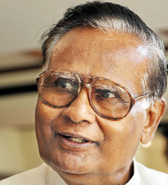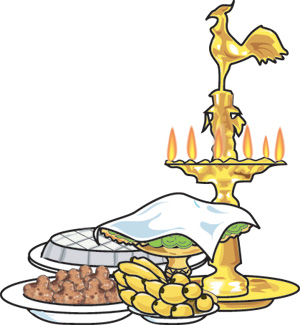In the days of the Kandyan Kingdom, where the traces of Sinhala culture were better preserved, there were four major national festivals, namely, Aluth Sahal Mangalyaya (festival of new rice) held in January, Sinhala and Hindu New Year that came in the middle of April, Esala Perahera in August and finally the Karthi Mangalyaya - a festival of light shared by both Tamils and Sinhalese that was held in November. Of these festivals, Sinhala that Hindu New Year was the most prominent.

Prof. Madduma Bandara |
The astrological timing of all Sinhala festivities was largely based on the chandra masa (lunar month), whereas in Hindu tradition, it was based on surya masa (solar month). The Sinhala and Hindu New Year is perhaps the sole exception where it was based on surya masa to mark the migration of the sun from meena rasi (Pisces) to mesa rasi (Taurus).
At the palace of the King, the royal astrologer (nekath mohottala) prepared the astrological charts for the New Year and announced it to the rest of the country. Thus the auspicious time of the dawning of the New Year after the nonagathe (the transitional period between the Old and New Years), the time for the lighting the hearth, the auspicious time for the partaking of the first meal in the New Year, the time for the anointing of herbal oils and the time for leaving for work in the New Year were all decided and announced in advance.
These traditional practices are followed across the country despite all historical vicissitudes, particularly in the rural areas where over 30% of the people in the country live. Since these practices are followed by both Buddhists and Hindus and some Christians as well, the New Year festival is indeed a national festival. It generates fellow-feeling and national cohesion. The Esala Perehera too exhibits this unique quality where all major ethnic groups participate.
 As children, our parents taught us the virtues of the whole country lighting the hearth at the same time, partaking of the first meal at the same time and starting work at the same time. It is perhaps the diminishing of such sentiments that landed us in a protracted civil war that lasted over three decades. However, at the Sri Dalada Maligawa, New Year customs are still practised and preserved as in the good old days. For instance, the herbal oils used for anointing are prepared there and distributed to many temples in the area. At the official residence of the Maha Nayake of Malwatte, the old national flag (not the present one) which was hoisted for the last time by Venerable Wariayapola Sumangala, begins to fly on the flag pole on New Year's Day. As children, our parents taught us the virtues of the whole country lighting the hearth at the same time, partaking of the first meal at the same time and starting work at the same time. It is perhaps the diminishing of such sentiments that landed us in a protracted civil war that lasted over three decades. However, at the Sri Dalada Maligawa, New Year customs are still practised and preserved as in the good old days. For instance, the herbal oils used for anointing are prepared there and distributed to many temples in the area. At the official residence of the Maha Nayake of Malwatte, the old national flag (not the present one) which was hoisted for the last time by Venerable Wariayapola Sumangala, begins to fly on the flag pole on New Year's Day.
Childhood reminiscences
Born in an ancient tank village (Puranagama) of Nuwarakalaviya in the early 1940s, I remember the New Year festivities in my little community of about 35 families, just before the dawn of Independence. It is a village located about 25 miles from the city of Anuradhapura in the eastern part of the district towards Trincomalee.
My father happened to be the Velvidane or the Head of the Village -a hereditary position he held for nearly 36 years until the Paddy Lands Act (Kumburu Panatha) came in the mid-1950s and the Cultivation Committee system was introduced. Therefore, our house (straw-thatched and with a floor of goma meti or a mixture of cow-dung and humbas meti or reddish soils from the termite hills), was often the centre of village ceremonies including that of the New Year and the oil anointing ceremony that followed.
The 'New Year heat' begins to spread after the Maha season harvest that concludes a few weeks before the New Year. The first signs of the New Year preparations were seen in the renovation and cleaning of houses and polishing of all household brassware including, pittala pan (brass lamps), pittala kalagedi (brass water pots), ilattattu (betel server), seruvakkkal (meal server) and sembu or small brass pots used for drinking water. As children we had to help our mothers and sisters to polish them with coconut husk or pol mudu at the village tank.
There was no electricity in the village then, and the same situation prevails even today after more than 60 years! So lighting was by mee thel or oil from the seeds of mee trees, which repelled mosquitoes and gave an aromatic smell.
With the New Year season approaching, more people seemed to gather in our maduwa in the evenings after a hard day's work for a chat and gossip. Although in January they gathered around the fire in the middle of the maduwa, in warm weather in March-April they spent their time chewing betel [or talakola (thulsi) - a local substitute] and arecanut, lime and tobacco.
There was the tradition of younger relatives visiting my parents with a bundle of betel signifying that they wished to be pardoned for any misdeeds in the fast finishing 'old year' or parana avurudda. On one occasion, I was surprised to see a distant relative who was drunk, coming to salute my father with a bundle of betel. My father was very angry but remained silent. I thought he would refuse to accept betel from the relative and throw him out. But before my father made any utterance, the relative asked for forgiveness for all misdeeds in the old year including his habit of drinking! Everything was thus settled amicably before the dawn of the New Year!
Sinhala and Hindu New Year customs - can they survive?
At the dawn of every New Year season, while enjoying the festive mood, I often wondered how long such traditional practices can survive in a fast changing world. Forces of globalization are sweeping across the world at an unprecedented scale. Will small nations and communities along with their unique cultures, be able to withstand these mammoth changes? Increased travel and migration are mixing up human populations and some speculate that even the US will become a 'brown' country in another 50 years. Sri Lanka is the only permanent home for Sinhala people.
Without the Sinhalese, there would be no Sinhala New Year. Because their identity is largely determined by the Sinhala Language, culture and customs. Both have come under visible as well as invisible threats. As a person nurtured in Buddhist thought, I am often compelled to believe that everything is impermanent and transitory. The same universal law will be true for Sinhalese, Tamil or Muslim identities.
At the same time, however, I am a believer in 'biodiversity' including, of course, 'human diversity', that is due to the laws of nature. When I was a small child there were at least seven or eight varieties of rice cultivated in my little village for different purposes. Now there are one or two hybrids like 'BG 11' or something similar. In my small ancient tank there were over 10 or 12 varieties of local fish, but now there are only a few like tilapia. Village forests have changed from their high diversity to virtual monocultures like teak and ipil.
Will it be a matter of time before the same thing happens to the rich but dwindling diversity of humans on earth. I find it difficult to be convinced that the world will be a happier place with one or two hybrid human types eating hamburgers and pizzas and drinking cola, playing a few games like cricket and soccer! I hold the conviction that richer the diversity, happier the world will become (peetho bhavatu loko).
This, however, is subject to the strict adherence to the basic overarching human value that among the different communities, equality and justice should necessarily prevail. It could be only under such a 'world-view', perhaps national festivities such as the Sinhala and Hindu New Year may survive for posterity. |


 As children, our parents taught us the virtues of the whole country lighting the hearth at the same time, partaking of the first meal at the same time and starting work at the same time. It is perhaps the diminishing of such sentiments that landed us in a protracted civil war that lasted over three decades. However, at the Sri Dalada Maligawa, New Year customs are still practised and preserved as in the good old days. For instance, the herbal oils used for anointing are prepared there and distributed to many temples in the area. At the official residence of the Maha Nayake of Malwatte, the old national flag (not the present one) which was hoisted for the last time by Venerable Wariayapola Sumangala, begins to fly on the flag pole on New Year's Day.
As children, our parents taught us the virtues of the whole country lighting the hearth at the same time, partaking of the first meal at the same time and starting work at the same time. It is perhaps the diminishing of such sentiments that landed us in a protracted civil war that lasted over three decades. However, at the Sri Dalada Maligawa, New Year customs are still practised and preserved as in the good old days. For instance, the herbal oils used for anointing are prepared there and distributed to many temples in the area. At the official residence of the Maha Nayake of Malwatte, the old national flag (not the present one) which was hoisted for the last time by Venerable Wariayapola Sumangala, begins to fly on the flag pole on New Year's Day. 